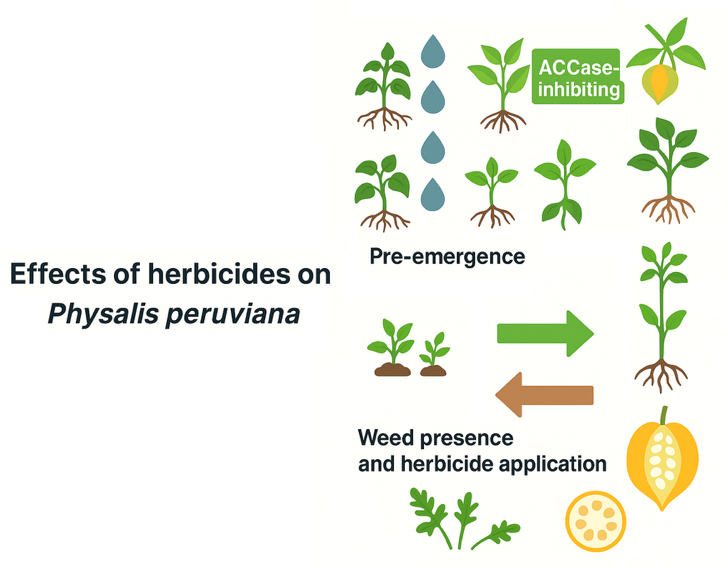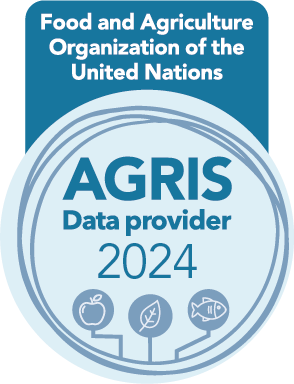Agronomic, physiological, and phytochemical responses of physalis to pre- and post-emergence herbicides
DOI:
https://doi.org/10.17268/sci.agropecu.2025.043Keywords:
Herbicide selectivity, Fruit quality, Physalis peruviana, herbicides, phytotoxicityAbstract
Cape gooseberry (Physalis peruviana L.) is a fruit crop with increasing economic and functional relevance, yet limited research exists on weed management practices for this species. This study aimed to evaluate the agronomic, physiological, and phytochemical responses of P. peruviana to various pre- and post-emergence herbicides under greenhouse and field conditions. Two biotypes were used to assess selectivity and crop tolerance to thirteen post-emergence and two pre-emergence herbicides. Post-emergence trials revealed that chlorimuron, fomesafen, and the mixture atrazine + simazine significantly reduced plant height and caused high phytotoxicity, especially under field conditions. Conversely, quizalofop, clethodim, fluazifop, and clodinafop (ACCase inhibitors) showed excellent selectivity and maintained yield levels comparable to the control. Pre-emergence applications of S-metolachlor exhibited minimal effects on plant growth and effectively reduced weed density, while imazaquin caused a dose-dependent reduction in plant height and yield, particularly in one biotype. Phenolic compound analysis indicated that both herbicide application and weed presence influenced fruit quality. Plants grown under weed-free conditions presented the highest total phenolic content, while high weed pressure or herbicide injury reduced phenolic accumulation, especially in biotype 2. The results demonstrate that while some herbicides pose risks to P. peruviana development, others offer promising weed control options with minimal impact on crop performance and fruit quality. These findings contribute to the development of safe and effective weed management strategies for this emerging crop.
References
Besançon, T. E., Wasacz, M. H., & Carr, B. L. (2020). Weed control and crop tolerance with S-metolachlor in seeded summer squash and cucumber. Weed Technology, 34(6), 849-856. https://doi.org/10.1017/wet.2020.72
Chiconi, L. A., Bacha, A. L., Braga, A. F., Carrega, W. C., Nepomuceno, M. P., & Alves, P. L. d. C. A. (2022). Selectivity of herbicides isolated and/or with the addition of adjuvants for Physalis angulata crop. Horticultura Brasileira, 40. https://doi.org/10.1590/s0102-0536-20220202
Cobb, A. H., & Reade, J. P. H. (2011). Herbicides and Plant Physiology: Wiley.
Coleman, M. J., Kristiansen, P., Sindel, B. M., & Fyfe, C. (2024). Imperatives for integrated weed management in vegetable production: Evaluating research and adoption. Weed Biology and Management, 24(1), 3-14. https://doi.org/10.1111/wbm.12285
Dai, S. Z., Wang, Y. W., Yook, M. J., Wu, H. Z., Chen, M., & Zhang, C. J. (2025). Screening of Pre- and Post-Emergence Herbicides for Weed Control in Camelina sativa (L.) Crantz. Agronomy-Basel, 15(3). https://doi.org/10.3390/agronomy15030640
de Oliveira, C., Mathioni, S. M., Riaño, A. D., Camargo, E. R., Dornelles, S. H. B., Lemes, L. N., . . . Avila, L. A. (2025). First report of barnyardgrass resistant to glyphosate in Brazil. Advances in Weed Science, 43. https://doi.org/10.51694/AdvWeedSci/2025;43:00010
Dhaouadi, F., Sellaoui, L., Taamalli, S., Louis, F., El Bakali, A., Badawi, M., . . . Rtimi, S. (2022). Enhanced adsorption of ketoprofen and 2,4-dichlorophenoxyactic acid on Physalis peruviana fruit residue functionalized with H2SO4: Adsorption properties and statistical physics modeling. Chemical Engineering Journal, 445. https://doi.org/10.1016/j.cej.2022.136773
Dittmar, P., Monks, D., Jennings, K., & Booker, F. (2012). Tolerance of Tomato to Herbicides Applied through Drip Irrigation. Weed Technology, 26, 684-690. https://doi.org/10.2307/23358271
Gazola, T., Gomes, D. M., Belapart, D., Dias, M. F., Carbonari, C. A., & Velini, E. D. (2021). Selectivity and residual weed control of pre-emergent herbicides in soybean crop. Revista Ceres, 68. https://doi.org/10.1590/0034-737X202168030008
Gnanasekaran, P. (2022). Effect of Post-Emergence Herbicides on Control of Weeds in Tomato During Kharif Season. International Journal of Farm Sciences, 12, 134-138. https://doi.org/10.5958/2250-0499.2022.00088.X
Grafiti. (2024). Sigmaplot. Palo Alto: Grafiti LLC.
Grammarly. (2025). Grammarly desktop. San Francisco. Retrieved from https://www.grammarly.com
Guiné, R. P. F., Gonçalves, F. J. A., Oliveira, S. F., & Correia, P. M. R. (2020). Evaluation of Phenolic Compounds, Antioxidant Activity and Bioaccessibility in Physalis peruviana L. International Journal of Fruit Science, 20(sup2), S470-S490. https://doi.org/10.1080/15538362.2020.1741056
Jin, Y. (2025). Validation of assay for measuring acetyl-coenzyme a carboxylase activity in grasses using malachite green. Analytical Biochemistry, 697. https://doi.org/10.1016/j.ab.2024.115723
Jones, E. A. L., Contreras, D. J., Argueta, R. J., Bradshaw, C., Leon, R. G., & Everman, W. J. (2024). Control of ALS- and PPO-inhibiting herbicide-resistant redroot pigweed (Amaranthus retroflexus) populations with common postemergence herbicides. Advances in Weed Science, 42. https://doi.org/10.51694/AdvWeedSci/2024;42:00039
Kashe, K., Ketumile, D., Kristiansen, P., Mahilo, C., & Moroke, T. (2020). Evaluation of pre-emergence herbicides for weed control in maize. Welwitschia International Journal of Agricultural Sciences, 2, 5-18. https://doi.org/10.32642/wijas.v2i.1437
Khodadadi, V., Yousefi, A. R., Shahbazi, S., Heydari, M., Kanatas, P., Tataridas, A., & Travlos, I. (2023). Evaluation of herbicides for selective weed control in cutleaf groundcherry (Physalis angulata L.). Crop Protection, 169. https://doi.org/10.1016/j.cropro.2023.106243
Kudsk, P., & Streibig, J. C. (2003). Herbicides – a two-edged sword. Weed Research, 43(2), 90-102. /https://doi.org/10.1046/j.1365-3180.2003.00328.x
Kukorelli, G., Reisinger, P. W. M., & Pinke, G. (2013). ACCase inhibitor herbicides – selectivity, weed resistance and fitness cost: a review. International Journal of Pest Management, 59, 165 - 173. https://doi.org/10.1080/09670874.2013.821212
McNaughton, K. E. (2013). Cumulative herbicide stress on processing tomato (Solanum lycopersicum L.). University of Guelph,
Muniz, J., Molina, A. R., & Muniz, J. (2015). Physalis: Panorama produtivo e econômico no Brasil. Horticultura Brasileira, 33. https://doi.org/10.1590/S0102-053620150000200023
Nosratti, I., Sabeti, P., Chaghamirzaee, G., & Heidari, H. (2020). Weed problems, challenges, and opportunities in Iran. Crop Protection, 134. https://doi.org/10.1016/j.cropro.2017.10.007
OpenAI. (2025). ChatGPT. San Francisco: OpenAi. Retrieved from https://chat.openai.com/
Pérez, M., Dominguez-López, I., & Lamuela-Raventós, R. M. (2023). The Chemistry Behind the Folin-Ciocalteu Method for the Estimation of (Poly)phenol Content in Food: Total Phenolic Intake in a Mediterranean Dietary Pattern. J Agric Food Chem, 71(46), 17543-17553. https://doi.org/10.1021/acs.jafc.3c04022
R Development Core Team. (2025). A language and environment for statistical computing. Viena: R Foundation for Statistical Computing. Retrieved from https://www.r-project.org
Raja, T., Devarajan, Y., Jayasankar, P., Singh, D., Subbiah, G., & Logesh, K. (2024). Characterization and sustainable applications of galinsoga parviflora natural fibers: A pathway to eco-friendly material development. Results in Engineering, 24. https://doi.org/10.1016/j.rineng.2024.103601
Rosenthal, M. D. A., Procópio, S. O., Pinto, J. J. O., Júnior, E. A. J., Peres, W. B., Manica, R., . . . Franzini, W. (2006). S-metholachlor toxicity in maize plants originated from seeds with different sizes and shapes. 24(2), 319-327. https://doi.org/10.1590/s0100-83582006000200015
Santana, A. S., Giacobbo, C. L., Prado, J. d., Uberti, A., Louis, B., & Alberto, C. M. (2020). Fenologia e qualidade de frutos de acessos de Physalis spp. Agrarian, 13(47), 1-8. https://doi.org/10.30612/agrarian.v13i47.8687
Santos, H. G. d., Jacomine, P. K. T., Anjos, L. H. C. d., Oliveira, V. A. d., Lumbreras, J. F., Coelho, M. R., . . . Cunha, T. J. F. (2018). Sistema Brasileiro de Classificação de Solos (5 ed.). Brasiília: Embrapa.
Uljol, L. H. O., Bianco, S., Filho, A. B. C., Bianco, M. S., & Carvalho, L. B. (2018). Weed Interference on Productivity of Bell Pepper Crops. Planta Daninha, 36. https://doi.org/10.1590/S0100-83582018360100046
Velasquez, J. C., Hoyos, V., Roma-Burgos, N., & Plaza, G. (2024). Weedy rice resistance to imidazolinone herbicides and control with glyphosate. Advances in Weed Science, 42. https://doi.org/10.51694/AdvWeedSci/2024;42:00035
Yari, P., Alirezalu, A., & Khalili, S. (2025). A comparative study of chemical composition, phenolic compound profile and antioxidant activity of wild grown, field and greenhouse cultivated Physalis (P. alkekengi and P. peruviana). Food Production, Processing and Nutrition, 7(1), 19. https://doi.org/10.1186/s43014-024-00287-9
Yu, Q., & Powles, S. B. (2014). Metabolism-based herbicide resistance and cross-resistance in crop weeds: a threat to herbicide sustainability and global crop production. Plant Physiology, 166(3), 1106-1118. https://doi.org/10.1104/pp.114.242750

Downloads
Published
How to Cite
Issue
Section
License
Copyright (c) 2025 Scientia Agropecuaria

This work is licensed under a Creative Commons Attribution-NonCommercial 4.0 International License.
The authors who publish in this journal accept the following conditions:
a. The authors retain the copyright and assign to the magazine the right of the first publication, with the work registered with the Creative Commons attribution license, which allows third parties to use the published information whenever they mention the authorship of the work and the First publication in this journal.
b. Authors may make other independent and additional contractual arrangements for non-exclusive distribution of the version of the article published in this journal (eg, include it in an institutional repository or publish it in a book) as long as it clearly indicates that the work Was first published in this journal.
c. Authors are encouraged to publish their work on the Internet (for example, on institutional or personal pages) before and during the review and publication process, as it can lead to productive exchanges and a greater and faster dissemination of work Published (see The Effect of Open Access).




